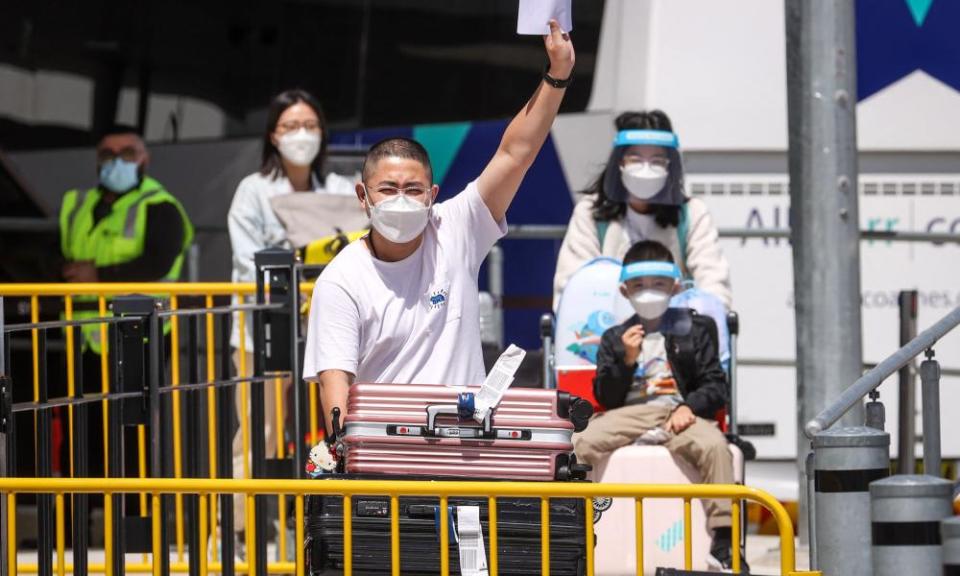As NSW opens to Australians stuck overseas, could more have been done to bring people home?

Australians stranded overseas have been handed some long-awaited relief, with the announcement that from 1 November, citizens, their family, and permanent residents will be prioritised for travel into New South Wales.
The number of Australians stuck overseas was at its peak in mid October, according to the Department of Foreign Affairs and Trade (Dfat) data, which put the figure at about 47,000.
Since the pandemic began, more than 57,000 people have returned to Australia on government-assisted flights.
But analysis of publicly available data suggests that many more Australians could have returned, due to spaces in quarantine facilities potentially going unused.
Many of those returning with government assistance have quarantined in the Howard Springs quarantine facility. In addition to the excess capacity of Howard Springs, analysis of flights and passenger caps shows that more returnees could have come through the hotel quarantine system.
Some who have been through the repatriation process have spoken of it being unfair, as Australians must race each other in order to claim seats on repatriation flights.
“You get an email and within one hour you need to buy the ticket,” says “Trevor”, who did not want to be named.
Related: NSW to end quarantine for fully vaccinated international arrivals
Trevor left Australia in July due to a family emergency, but had his return tickets cancelled after the passenger caps for some states were halved. He says he was lucky that he was able to get a repatriation flight on his first try, but it ended up costing significantly more than his original tickets.
Guardian Australia sent repeated requests to the Australian Border Force and the Northern Territory department of health for data on the capacity and utilisation rate of Howard Springs over time. None was forthcoming.
Analysis of press releases, media reports and public statements suggests that the total possible number of people that could have been accommodated in the Howard Springs facility was approximately 25-27,000 since it came into use a year ago.
17,700 actually transited through the camp, according to NT Health.
“The utilisation of [Howard Springs] varies depending on the arrival of repatriation flights and declared domestic Covid-19 hotspots, and continually shifts based on the entry and exit of residents after their quarantine period is complete,” a NT Health spokesperson said.
“[Howard Springs] continues to maintain adequate capacity to manage domestic and international quarantine requirements.”
An NT Health spokesperson told Guardian Australia that the current capacity of Howard Springs is 2,000 international arrivals a fortnight, as of August. Using this, media reports and statements from the prime minister, Guardian Australia constructed an estimation of the capacity over time.
The camp was said to be able to hold 500 international arrivals when it entered service as a quarantine facility in October 2020. In December this was expanded to 850 places. In June the NT government confirmed there were 1098 people at Howard Springs, and told Guardian Australia there were 1344 in July.
Over a similar period that 17,700 people passed through Howard Springs, the UK government repatriated over 18,000 people from India alone. The UK Foreign Office annual report states that 132,000 British nationals were “directly assisted” by the UK government, on over 186 charter flights, throughout the pandemic.
There were more than 289,000 international arrivals in Australia between July 2020, when the passenger caps were first introduced, and the end of July 2021, the last date for which the Department of Home Affairs has published data. This does not include arrivals from New Zealand after October 2020, when quarantine-free travel began.
This an estimated 10,000 fewer arrivals than should have been allowed under the established passenger caps, up until August 2021. A firm number on the total cap on international arrivals into Australia was not forthcoming from Dfat or the Australian Border Force.
Some states refused to confirm even the current passenger caps.
Some states halved their international passenger caps in August due to ongoing outbreaks, stranding even more Australians.
Between 1 June 2021 and the middle of October there were almost 64,000 locally acquired cases in NSW and 265 overseas-acquired cases.
The New South Wales government has now announced that all quarantine requirements will be removed from the 1st of November.
Notes and methods:
Estimated number of stranded Australians over time estimated using press releases, interviews, media reports and official statements
Howard Springs estimated capacity estimated using press releases, interviews, media reports and official statements
Howard Springs occupancy estimated using the initial and total occupancy of the facility, provided by NT Health
Arrivals into Australia turned into a daily average from Australian Border Force data, excluding arrivals from New Zealand after October 2020.

 Yahoo News
Yahoo News 